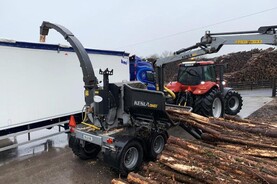As we know, there is strong potential for Irish farmers to not only be world leaders in sustainable food production, but sustainable producers of renewable fuels and fibre.
This would assist the agriculture, heat and transport sectors to decarbonise and reduce emissions. It would also provide opportunity by diversifying farming and increased farm incomes.
Wide-scale deployment of bioenergy is the obvious choice.

Seán Finan, CEO, IrBEA.
Bioenergy, which is the world’s largest source of renewable energy, and in solid, liquid or gaseous form, is generated from biomass, biological sources and organic material widely available in Irish farms.
Currently, a blind spot exists in Irish policy
The economics of bioenergy are strongest when locally grown feedstock are harvested and processed to satisfy energy demands through short supply chains.
Currently, a blind spot exists in Irish policy and support towards bioenergy compared to other renewable energy technologies.
A 2017 European Commission report, An assessment of the potential of biogas from digestion in the EU beyond 2020, identifies that the member state with the largest potential for growth of biogas production is Ireland.
Biomass
While biogas is a key element, bioenergy also includes biomass and biofuels, which offer Irish farmers and the wider agriculture industry multi-sectoral benefits.
These are not currently valued but include rural development, indigenous generated renewable energy, provide alternatives to chemical fertiliser through digestate, growing the bioeconomy, enhancing biodiversity, alternative income streams for farmers and enterprise diversification.
Irish farmers can sustainably produce many forms of feedstock for solid, liquid and gaseous bioenergy.
Examples include forest thinning as part of sustainable forest management, slurries, waste residues and feedstock for biogas generation, crops specifically grown to produce biofuels and biomass used to produce biochar.
All of this bioenergy can be grown, and in some cases used on farms to generate electricity, heat or transport fuels.
SSRH
The Support Scheme for Renewable Heat (SSRH) supports renewable heat generation while ensuring that biomass is sourced through sustainable forest management as governed by strict criteria in the RED II Directive.
Fossil fuels can be displaced with indigenous resources such as biogas, bioliquids, energy crops, woodchip and firewood.
Challenge
The scale of the challenge in meeting emissions reduction targets in agriculture and all aspects of our lives is enormous.
None of the solutions proposed today will get us to where we need to be by 2030 or 2050.
Many stakeholders in agriculture acknowledge that the Irish policy and regulatory landscape is seen as an impediment to the development of bioenergy.
There is a need to focus on pragmaticism over ideology and recognising that bioenergy has a significant part to play.
With investment, support and the right policy framework the potential of bioenergy to assist in Irish farming emissions reduction efforts can be realised.
As we know, there is strong potential for Irish farmers to not only be world leaders in sustainable food production, but sustainable producers of renewable fuels and fibre.
This would assist the agriculture, heat and transport sectors to decarbonise and reduce emissions. It would also provide opportunity by diversifying farming and increased farm incomes.
Wide-scale deployment of bioenergy is the obvious choice.

Seán Finan, CEO, IrBEA.
Bioenergy, which is the world’s largest source of renewable energy, and in solid, liquid or gaseous form, is generated from biomass, biological sources and organic material widely available in Irish farms.
Currently, a blind spot exists in Irish policy
The economics of bioenergy are strongest when locally grown feedstock are harvested and processed to satisfy energy demands through short supply chains.
Currently, a blind spot exists in Irish policy and support towards bioenergy compared to other renewable energy technologies.
A 2017 European Commission report, An assessment of the potential of biogas from digestion in the EU beyond 2020, identifies that the member state with the largest potential for growth of biogas production is Ireland.
Biomass
While biogas is a key element, bioenergy also includes biomass and biofuels, which offer Irish farmers and the wider agriculture industry multi-sectoral benefits.
These are not currently valued but include rural development, indigenous generated renewable energy, provide alternatives to chemical fertiliser through digestate, growing the bioeconomy, enhancing biodiversity, alternative income streams for farmers and enterprise diversification.
Irish farmers can sustainably produce many forms of feedstock for solid, liquid and gaseous bioenergy.
Examples include forest thinning as part of sustainable forest management, slurries, waste residues and feedstock for biogas generation, crops specifically grown to produce biofuels and biomass used to produce biochar.
All of this bioenergy can be grown, and in some cases used on farms to generate electricity, heat or transport fuels.
SSRH
The Support Scheme for Renewable Heat (SSRH) supports renewable heat generation while ensuring that biomass is sourced through sustainable forest management as governed by strict criteria in the RED II Directive.
Fossil fuels can be displaced with indigenous resources such as biogas, bioliquids, energy crops, woodchip and firewood.
Challenge
The scale of the challenge in meeting emissions reduction targets in agriculture and all aspects of our lives is enormous.
None of the solutions proposed today will get us to where we need to be by 2030 or 2050.
Many stakeholders in agriculture acknowledge that the Irish policy and regulatory landscape is seen as an impediment to the development of bioenergy.
There is a need to focus on pragmaticism over ideology and recognising that bioenergy has a significant part to play.
With investment, support and the right policy framework the potential of bioenergy to assist in Irish farming emissions reduction efforts can be realised.







 This is a subscriber-only article
This is a subscriber-only article










SHARING OPTIONS: